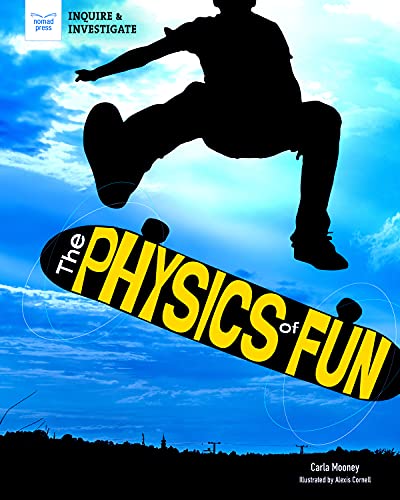The Physics of Fun
Genre: middle grade | nonfiction | science | sports | YA

Author: Carla Mooney
Publisher: Nomad Press
[widget id="post-tags-widget-2"]
Why are you able to jump higher from a trampoline than from the ground? What forces are at work when you do an ollie on a skateboard? The answer is: physics! In The Physics of Fun, kids ages 12 to 15 explore the science behind awesome activities that kids love. From Newton’s laws of motion to the behavior of electrons, the science of physics is an integral part of any amusement park, play center, video arcade or home gaming center. Links to online media, discussion questions and career connections offer middle schoolers the chance to do some real, hands-on science around fun activities they already enjoy!
This is certainly the introduction to physics that I would have liked to have in middle school. As it was, our textbook gave us some basics but never inspired me to go further, and as a result, I opted out of taking physics in high school. That’s one regret I have from high school, as I have become much more interested in physics as an adult, and I have had to learn things from scratch on my own instead.
My first impression of this book reminded me of the early 90s, when everyone was trying to make [insert topic] “fun” or “cool” by putting it to a rap or involving skateboarding somehow. That sort of cheese doesn’t connect to everyone, so I was genuinely surprised when this book turned out to be more detailed and applicable than kitschy. And while I think its visual motif is still a little bit in that direction, which could be off-putting to some, it does make it easier to read overall.
The first few concepts focus a lot on sports, as one would expect from a book on physics and from the cover, but I was pleasantly surprised that there were lessons for the non-jock as well, covering things like music and electronics. There are also fun facts, and QR links to videos or other supplemental materials, though some of these latter are lower quality than I would have hoped.
As a teacher, I’m picturing what a classroom using this as a textbook (or as one of several supplemental materials) would be like. Certainly, it’s not high-school level physics, but it does have a lot of fun experiments that one could do in a group setting or individually. This would be great for a self-study or homeschool setting, and while it’s clearly geared toward ages 12-15, it’s probably useful for some younger and some older as well. I’m 41 and still learned something! My 7- and 10-year-old would probably enjoy much of it as well.
It's a hard balance to strike between the easily comprehensible concepts, such as gravity’s effect on a snowboarder, and the harder terminology, laws, calculations and details that learning physics involves. It’s either dumbed down so far as not to be physics, or the reader will probably not grasp everything the first time. This book seems to take the second route, making it helpful to approach this book as either step 2 of 3+, or as one you’ll want to revisit for mastery later, once the introduction sinks in.
The biggest strengths for this book are its engaging content, the easy experiments and its bold attempt to make a difficult topic approachable. Its biggest weaknesses are the linked materials, the “hip” visual style (which will likely feel outdated quickly), and the places where tough terminology like “rarefaction” and “semiconductor” may bog the younger readers down without really getting through.
With proper instruction or repetition, I think I could learn as much from this middle-school level physics book as I ever did from the traditional textbook. And I’d have a lot more fun doing it. I’m certainly going to pass it along to my kids (ages 7-14) and see how they enjoy it. And whether it’s your main resource or just one of many, it’s a valiant attempt at inspiring new learners to explore the world of physics…which is to say, the universe.
-Jon Gill
no-repeat;left top;; auto
